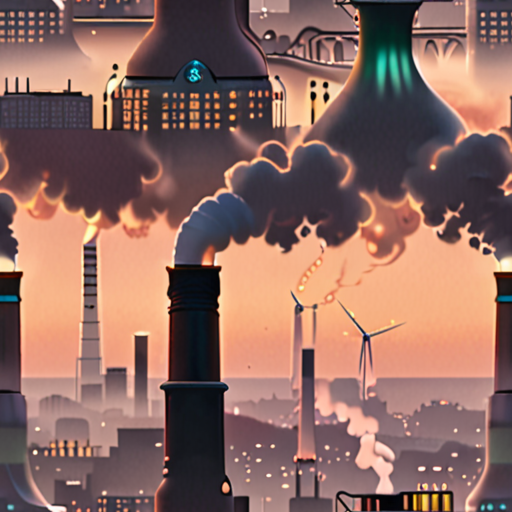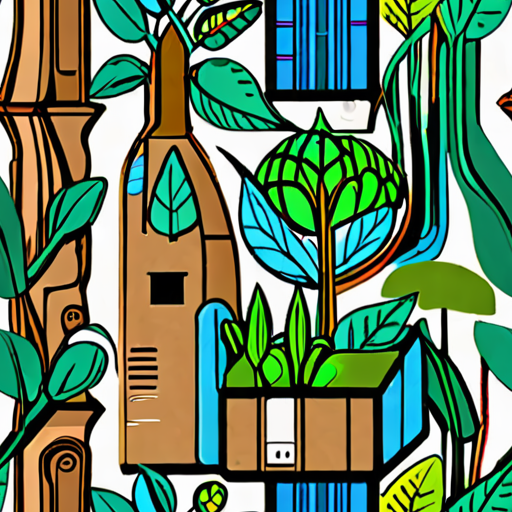As the world grapples with the challenges of climate change, environmental degradation, and resource depletion, the need for innovative and effective waste management strategies has never been more pressing. One critical aspect of achieving a greener tomorrow lies in adopting sustainable waste conversion practices that minimize waste generation, promote recycling and reuse, and convert non-renewable resources into valuable energy sources. By harnessing cutting-edge technologies and implementing evidence-based policies, we can transform our approach to waste management and create a more circular economy.

Sustainable Waste Management Strategies
The 5 Rs remain a cornerstone of sustainable waste management: Refuse, Reduce, Reuse, Repurpose, and Recycle.
-
Refuse
Refusing unnecessary items reduces waste generation. Be mindful of packaging, choose products with minimal or biodegradable packaging, and decline single-use plastics.
-
Reduce
Reducing consumption decreases waste production. Adopt a minimalist lifestyle, buy in bulk, and choose products with minimal packaging.
-
Reuse
Reusing items extends their lifespan and conserves resources. Repurpose old items, donate gently used goods, and reuse containers.
-
Repurpose
Repurposing gives new life to discarded items. Get creative with DIY projects, turn old items into planters, and transform trash into treasure.
-
Recycle
Recycling converts waste into valuable resources. Participate in curbside recycling programs, compost organic waste, and recycle paper, plastic, glass, and metal.
Additional Strategies
In addition to the 5 Rs, consider these supplementary approaches:
-
Composting
Composting turns food waste into nutrient-rich soil. Create a home compost bin, participate in community composting programs, or purchase composted products.
-
Upcycling
Upcycling transforms waste into higher-value products. Get creative with art projects, turn old furniture into unique pieces, and repurpose materials for construction.
-
Waste-to-Energy
Waste-to-energy technologies convert waste into energy. Explore options like anaerobic digestion, gasification, and plasma arc gasification.
-
Circular Economy
A circular economy promotes waste reduction through design and production. Encourage companies to adopt circular business models, design for recyclability, and implement take-back programs.
Best Practices
To maximize the effectiveness of sustainable waste management strategies:
-
Implement waste segregation
Separate waste into categories like organic, inorganic, and hazardous waste.
-
Monitor progress
Track waste generation, recycling rates, and composting levels to identify areas for improvement.
-
Foster community engagement
Organize workshops, events, and educational campaigns to promote sustainable waste management practices among residents and businesses.
-
Collaborate with stakeholders
Work with local governments, businesses, and organizations to develop and implement effective waste management policies and programs.
Conversion in Waste Management
Conversion in waste management refers to the process of transforming non-recyclable waste into usable forms of energy, including heat, fuels, and electricity.
- Types of Conversion Processes
- Incineration: A high-temperature combustion process that converts waste into ash, flue gas, and heat.
- Gasification: A process that converts waste into synthesis gas, which can be used to produce electricity or heat.
- Pyrolysis: A thermal decomposition process that converts organic materials into bio-oil, bio-gas, and bio-char.
- Anaerobic Digestion: A process that converts organic waste into biogas, which can be used to produce electricity or heat.
- Landfill Gas Recovery: A process that captures methane emissions from landfills and uses them to produce electricity or heat.
- Reduces greenhouse gas emissions
- Conserves landfill space
- Provides renewable energy source
- Creates jobs and stimulates local economies
- High upfront costs
- Technical complexity
- Public acceptance issues
- Regulatory hurdles
- Implementing efficient waste sorting and collection systems
- Investing in advanced conversion technologies
- Developing public education and outreach programs
- Fostering collaboration between stakeholders
Benefits of Conversion in Waste Management
Challenges and Limitations
Best Practices for Conversion in Waste Management
Conclusion
Conversion in waste management offers numerous benefits, including reduced greenhouse gas emissions, conserved landfill space, and a renewable energy source. However, challenges and limitations must be addressed through best practices, including efficient waste sorting and collection systems, investment in advanced conversion technologies, public education and outreach programs, and stakeholder collaboration.

How Does WTE Work?
Waste-to-Energy (WTE) is a process that converts non-recyclable waste into electricity or heat.
- The process begins with the collection and transportation of municipal solid waste (MSW), which is then sorted and processed to remove contaminants.
- The sorted waste is then fed into a furnace, where it is burned at high temperatures to produce steam.
- The steam is then used to power a turbine, generating electricity.
Key Components of WTE Plants
- Furnace: Where the waste is burned to produce steam.
- Turbine: Converts the steam into electricity.
- Boiler: Produces steam from the combustion of waste.
Benefits of WTE
- Reduces landfill waste.
- Generates renewable energy.
- Can be used to produce heat for industrial processes.
Comparison to Other Technologies
While WTE has its benefits, it is essential to consider alternative technologies, such as recycling and composting, which can also divert waste from landfills and produce energy.
Industry Leaders in WTE
- Veolia: A global leader in waste management and WTE.
- Covanta: A leading provider of WTE services in North America.
Future Developments in WTE
Advances in technology are expected to improve the efficiency and effectiveness of WTE plants, making them a more viable option for waste management.
Best Practices for Implementing WTE
- Implementing effective waste sorting and processing systems.
- Regular maintenance of equipment to ensure optimal performance.
- Monitoring and reporting emissions to ensure compliance with regulations.

The 5 Rs of Sustainability and Zero Waste
We believe that adopting sustainable practices is crucial for reducing our environmental footprint and promoting a healthier planet.
-
Refuse
Refusing unnecessary items is the first step towards minimizing waste. By saying no to single-use plastics, paper products, and other non-essential items, we can significantly reduce the amount of waste generated.
-
Reduce
Reducing consumption is another vital aspect of the 5 Rs. We can start by buying in bulk, choosing products with minimal packaging, and avoiding impulse purchases.
-
Reuse
Reusing items is a great way to extend their lifespan and reduce waste. From reusable bags and containers to old clothes and household items, there are countless ways to give new life to discarded goods.
-
Repurpose
Repurposing items involves finding creative ways to reuse them in a different context. For example, turning old pallets into planters or using glass jars as vases.
-
Recycle
Recycling is an essential part of the 5 Rs, allowing us to convert waste into valuable resources. By recycling paper, plastic, glass, and metal, we can conserve natural resources and reduce landfill waste.
At Pyrolysium , we’re committed to spreading awareness about sustainable living and eco-friendly technologies. Our mission is to educate and inspire individuals to adopt environmentally responsible habits and contribute to a cleaner, greener future.
Some notable organizations working towards similar goals include EPA and UNEP . These institutions play a vital role in promoting sustainable development and protecting the environment.
By embracing the 5 Rs and making conscious choices in our daily lives, we can collectively create a positive impact on the planet and ensure a brighter future for generations to come.
The 5 Rules of Sustainability
I’m passionate about living sustainably and reducing my environmental footprint, which is why I’ve learned about the 5 rules of sustainability.
-
Refuse
Refusing what we don’t need is the first step towards living sustainably. This means saying no to single-use plastics, avoiding products with excess packaging, and choosing second-hand items over new ones.
-
Reduce
Reducing our consumption is crucial in minimizing waste and conserving resources. We can start by assessing our daily habits and making conscious choices to buy only what we need, using energy-efficient appliances, and turning off lights and electronics when not in use.
-
Reuse
Reusing items is a great way to extend their lifespan and reduce waste. We can repurpose old containers, bags, and other items for various purposes, and encourage others to do the same.
-
Recycle
Recycling is essential in managing waste and conserving natural resources. We can recycle paper, plastic, glass, and metal, and participate in community recycling programs to minimize landfill waste.
-
Rot
Rotting organic waste is a natural process that reduces greenhouse gas emissions and creates nutrient-rich soil. We can compost food scraps, yard trimmings, and other organic materials to create a sustainable gardening solution.
By following these 5 rules of sustainability, we can significantly reduce our environmental impact, conserve resources, and promote a healthier planet for future generations.

The 5R Rule: A Comprehensive Guide to Sustainable Living
We believe that reducing waste and promoting sustainability should be a core part of our daily lives.
-
Reduce
Reducing waste starts with making conscious choices about the products we buy and use. By choosing items with minimal packaging, buying in bulk, and avoiding single-use plastics, we can significantly decrease the amount of waste we generate.
At Pyrolysium , we’re committed to helping you make informed decisions about the products you bring into your home.
-
Reuse
Reusing items is a great way to extend their lifespan and reduce waste. From reusable bags and containers to second-hand clothing and furniture, there are countless ways to give old items new life.
Get creative and find new uses for items you might otherwise throw away!
-
Recycle
Recycling is an essential step in the waste reduction process. By properly sorting and processing recyclable materials, we can conserve natural resources and reduce greenhouse gas emissions.
Make sure to check what materials are accepted in your local recycling program and do your part to keep these materials out of landfills.
-
Collect
Collecting waste separately is crucial for effective recycling and composting. By setting up designated collection bins for different types of waste, we can ensure that materials are processed correctly and don’t end up in landfills.
Invest in a few simple collection bins and get started today!
-
Recover
Recovering energy and nutrients from waste is a game-changer for sustainability. Through processes like anaerobic digestion and pyrolysis, we can turn waste into valuable resources like biogas and biochar.
Learn more about the benefits of recovering energy and nutrients from waste and discover how you can make a difference.
Conclusion:
The 5R rule is a powerful tool for achieving a more sustainable lifestyle. By reducing, reusing, recycling, collecting, and recovering waste, we can significantly reduce our environmental footprint and promote a healthier planet for future generations.
At Pyrolysium , we’re dedicated to empowering you with the knowledge and resources needed to live sustainably. Join us on this journey and together, let’s create a better world for everyone!

0 Comments